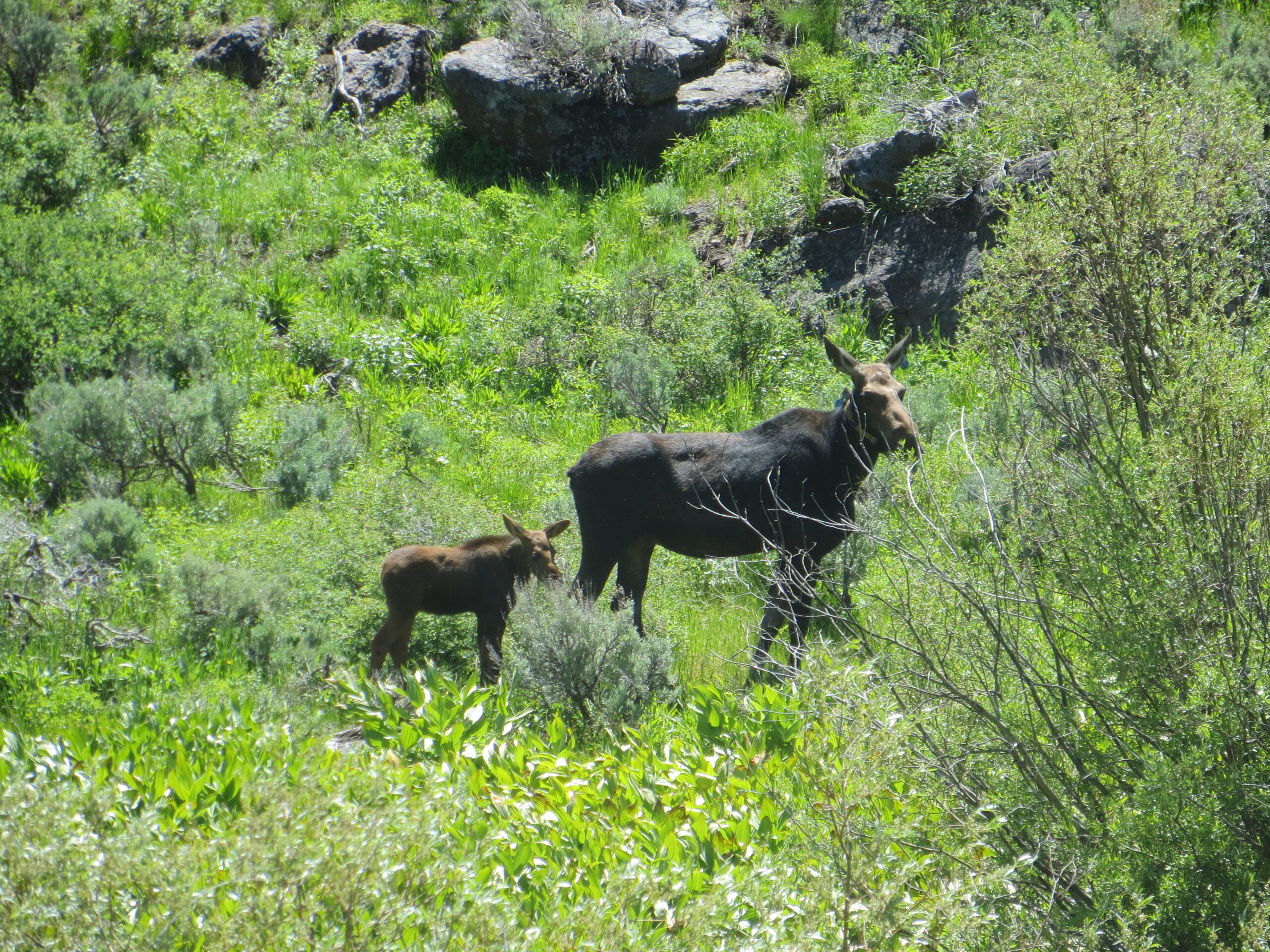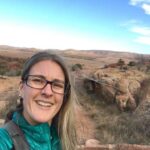Indy Environment: Think you saw a moose in Nevada? You might not be moosetaken

Good morning, and welcome to the Indy Environment newsletter. I'm Amy Alonzo, the environment reporter for The Indy.
I remember the first — and only — time I saw a moose in the wild.
I was driving through New England and “moose crossing” signs peppered the highway — but I hadn’t seen a moose myself.
While hiking around Cannon Cliff, a large rocky outcrop nestled in a thick bed of deciduous trees, lakes and streams in New Hampshire, a group of seemingly intoxicated anglers told us there was a moose up ahead. My partner and I rounded a bend in the trail, and there it was. A moose. And it was HUGE.
Even from a couple hundred feet away, its size was staggering. I was expecting something the size of, say, a horse. As someone who grew up in the West, that was the largest animal I’d seen in the wild.
This moose was so much bigger. It looked like we could have driven our car between its legs.
It eyed us and ambled off while we backtracked in the opposite direction.
I’d seen my moose. And more Nevadans might get that chance in their home state going forward.
As always, we want to hear from readers. Let us know what you’re seeing on the ground and how policies are affecting you. Email tips to me at [email protected]. To get this newsletter in your inbox, subscribe here.

Standing roughly 6 feet tall at the shoulder with spindly legs and bulbous torsos, moose are lanky, awkward and the second-largest mammal in North America.
With a propensity to spend their time in thick stands of vegetation and brush, they are populous in cold northern states such as Alaska (home to 175,000 moose) and Maine.
But the population is growing — including in Nevada. The state’s moose population has grown over the past few years to number more than 100 across the northern part of the state. The ungulates (hoofed mammals) are late arrivals to North America with no evidence that they inhabited Nevada prior to European settlement, expanding into southern latitudes with hospitable climates, abundant food and few natural predators.
The ungulates' arrival and spread across Northern Nevada has come without the assistance of state wildlife managers — many of whom are giddy over the species’ current success.
“It’s a really cool story,” said Cody McKee, elk and moose staff specialist for the Nevada Department of Wildlife. “A lot of our big game species are in crisis … They’ve struggled through the last few years of drought and our epic winter last year. But here we have this success story and something we can all be excited about.”
But that success comes with a caveat. The bulls outnumber the cows in Nevada, and state wildlife managers say that can lead to challenges such as competitions between males and difficulties for cows raising their young.
State biologists estimate that more than half of the 110 moose in the state are bulls, while a healthier ratio would be one bull for every two cows.
Under a framework established by state lawmakers in 2019, the Nevada Department of Wildlife will be issuing a yet-to-be-determined number of hunting tags this year for a limited number of bulls to make a dent in the population disparity. It marks the first time the state has issued tags for moose and the first time in 40 years the agency has issued tags for a new ungulate species.
Hunters who secure a Nevada tag will have a once-in-a-lifetime opportunity — anyone who is issued a tag in Nevada will not be awarded a second one. With no commercial moose farms in the United States, moose is a delicacy that can only be enjoyed by hunting. The tag also comes with a steep price tag: $120 for residents and $1,200 for nonresidents.
But the price isn’t deterring hopeful Nevadans.
“There’s a lot of interest,” according to Bill Gibson of Elko Guide Services, who’s already received four or five calls from people asking if he could guide them. “And the answer is sure — if you can get a tag. I think there's going to be 10,000 applicants for two of the first moose tags. It’s going to be long odds.”
That’s partially because Nevada hunters are limited by residency and cost in other states. In Idaho, where moose populations are declining, 514 tags are being issued this year — 28 fewer than in years prior, and nonresident hunters are limited to no more than 10 percent of the total number of tags. In Utah, Nevadans would have to pay more than $2,200 for a bull moose tag.
A ‘population eruption’
Moose are relative newcomers to North America. They were the last deer species to cross into the continent before the Bering Land Bridge that connected to Asia flooded about 11,000 years ago.
Their expansion into the lower 48 states occurred during just the last 150 years.
“The post-glacial-range expansion isn’t yet complete, and that is what we are seeing in Nevada right now,” McKee said. “Those moose are moving into the state and finding suitable habitat.”
Moose were first observed in Nevada in the 1950s, and hunters were quick to capitalize — the first documented bull moose was harvested in Nevada around the same time.
Since the 1950s, there have been 552 documented moose observations in the state, primarily across Elko County and into the Ruby Mountains. A few have been spotted at the south end of the Santa Rosa Range near Winnemucca in Humboldt County.
By 1996, the state’s moose population had grown large enough that the state reported its first — and to this day, only — documented moose attack, near Elko County’s Bull Camp Creek, when a hunter with a deer tag got too close to a moose while taking a photo. After knocking the hunter unconscious, the moose wandered off. The victim’s brother administered first aid and drove the injured man to a hospital.
Between 2018 and 2022, there were an average of 57 moose sightings reported to state officials per year. In 2023 there were 170 observations, a 300 percent increase.
McKee described the growth as an unsustainable “population eruption.” Nevada’s moose are experiencing a 98 percent adult survival rate, among the highest in the Western United States, due in part to a lack of predators such as bears, cougars and wolves.
The swelling population hasn’t presented a problem yet. The ungulates are antisocial, and their numbers are spread out over such a large area they aren’t competing for forage with other species.
Prime potential habitat areas such as the Ruby Mountains have only a handful of moose thus far, and moose could continue expanding through the range toward central Nevada, although it’s unlikely they’ll make it any further. Access to water could limit their spread south, and inhospitable terrain to the west would likely prevent them from making their way into western Nevada or Lake Tahoe.
“It could happen,” McKee said. “But that might be a tough one.”
Population growth relies on females
While the size of the state’s moose population might not seem large enough to warrant hunting — for comparison, Nevada boasts roughly 14,000 elk and 70,000 deer — it’s not the number of moose, McKee said. It’s the demographics.
As moose settle in new areas, the first pioneers tend to be young males.
“Right off the get-go you end up with these skewed sex ratios,” he said. “In wild ungulate populations, when you have a lot of bulls on the landscape in relation to the number of cows, that can lead to competition. It can affect the cow’s ability to care for herself or her calf.”
State biologists have already seen that disparity. In one drainage area, one female was spotted — with seven males.
“That’s a whole lot of competition for a very limited reproductive event,” McKee said. “Males contribute very little to the health of the herd except for sperm. Population growth relies on the health of the females.”
How many tags will be issued in Nevada is yet to be determined.
In April, the Nevada Department of Wildlife will make a recommendation on the parameters of a tag system to the nine-member, governor-appointed Nevada Board of Wildlife Commissioners. The board, which establishes policy for the department, will ultimately make the decision, voting on it the first week of May.
The tags will be valid from Sept. 1 through Nov. 30 in portions of Elko County.
Prospective hunters should beware though. A bull will have anywhere from 400 to 700 pounds of meat and up to 65 pounds of antlers to transport away from the kill site.

Here’s what else I’m reading this week:
A peek underwater at the counting of Southern Nevada’s Moapa dace from the Las Vegas Review-Journal.
The Associated Press breaks down a study of how climate change is affecting the ski industry — and the future doesn’t look good.
An update on Colorado River negotiations — what’s been established and what’s next — by the Nevada Current.
